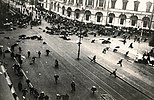 Global Information
Global InformationRussian Revolution information
| Part of the opposition to World War I and the Revolutions of 1917–1923 | |
Clockwise from top left:
| |
| Native name | Революция 1917 года (Revolution of 1917) |
|---|---|
| Date | 8 March 1917 – 16 June 1923 (6 years, 3 months and 8 days) |
| Duration |
|
| Location | Former Russian Empire |
| Participants |
|
| Outcome |
|
| Part of the Politics series |
| Republicanism |
|---|
|
|
The Russian Revolution was a period of political and social change in the Russian Empire, starting in 1917. This period saw Russia abolish its monarchy and adopt a socialist form of government following two successive revolutions and a bloody civil war. The Russian Revolution can also be seen as the precursor for the other European revolutions that occurred during or in the aftermath of World War I, such as the German Revolution of 1918–1919.
The Russian Revolution was inaugurated with the February Revolution in early 1917, in the midst of World War I. With the German Empire dealing major defeats on the war front, and increasing logistical problems in the rear causing shortages of bread and grain, the Russian Army was steadily losing morale, with large scale mutiny looming.[1] High officials were convinced that if Tsar Nicholas II abdicated, the unrest would subside. Nicholas agreed and stepped down, ushering in a new provisional government led by the Russian Duma (the parliament).
During the civil unrest, soviet councils were formed by the locals in Petrograd that initially did not oppose the new Provisional Government; however, the Soviets did insist on their influence in the government and control over various militias. By March, Russia had two rival governments. The Provisional Government held state power in military and international affairs, whereas the network of Soviets held more power concerning domestic affairs. Critically, the Soviets held the allegiance of the working class, as well as the growing urban middle class.
During this chaotic period, there were frequent mutinies, protests and strikes. Many socialist and other leftist political organizations were struggling for influence within the Provisional Government and the Soviets. Notable factions included the Social-Democrats or Mensheviks, Social Revolutionaries, and Anarchists, as well as the Bolsheviks, a far-left party led by Vladimir Lenin.
Initially the Bolsheviks were a marginal faction; however, they won popularity with their program promising peace, land, and bread: cease war with Germany, give land to the peasantry, and end the wartime famine.[2] Despite the virtually universal hatred of the war, the Provisional Government chose to continue fighting to support its allies, giving the Bolsheviks and other socialist factions a justification to advance the revolution further. The Bolsheviks merged various workers' militias loyal to them into the Red Guards, which would be strong enough to seize power.[3]
The volatile situation reached its climax with the October Revolution, a Bolshevik armed insurrection by workers and soldiers in Petrograd that overthrew the Provisional Government, transferring all its authority to the Bolsheviks. The Bolsheviks, acting in the framework of the soviet councils, established their own government, the Russian Soviet Federative Socialist Republic (RSFSR). Under pressure from German military offensives, the Bolsheviks soon relocated the national capital to Moscow. The RSFSR began the process of reorganizing the former empire into the world's first socialist state, to practice soviet democracy on a national and international scale. Their promise to end Russia's participation in the First World War was fulfilled when the Bolshevik leaders signed the Treaty of Brest-Litovsk with Germany in March 1918. To secure the new state, the Bolsheviks established the Cheka, a secret police and revolutionary security service working to uncover, punish, and eliminate those considered to be "enemies of the people" in campaigns called the Red Terror, consciously modeled on those of the French Revolution.
Although the Bolsheviks held large support in urban areas, they had many foreign and domestic enemies that refused to recognize their government. Russia erupted into a bloody civil war, which pitted the Reds (Bolsheviks), against their enemies, collectively referred to as the White Army. The White Army comprised independence movements, monarchists, liberals, and anti-Bolshevik socialist parties. In response, the Bolshevik commissar Leon Trotsky began organizing workers' militias loyal to the Bolsheviks into the Red Army. While key events occurred in Moscow and Petrograd, every city in the empire was convulsed, including the provinces of national minorities, and in the rural areas peasants took over and redistributed land.
As the war progressed, the RSFSR began to establish Soviet power in the newly independent republics that seceded from the Russian Empire. The RSFSR initially focused its efforts on the newly independent republics of Armenia, Azerbaijan, Belarus, Georgia, and Ukraine. Wartime cohesion and intervention from foreign powers prompted the RSFSR to begin unifying these nations under one flag and created the Union of Soviet Socialist Republics (USSR). Historians generally consider the end of the revolutionary period to be in 1923 when the Russian Civil War concluded with the defeat of the White Army and all rival socialist factions, leading to mass emigration from Russia. The victorious Bolshevik Party reconstituted itself into the Communist Party of the Soviet Union and would remain in power for the next 68 years.
- ^ Petrone, Karen (8 October 2017). "David R. Stone, The Russian Army in the Great War: The Eastern Front 1914–1917". The Journal of Power Institutions in Post-Soviet Societies. (18). doi:10.4000/pipss.4270. ISSN 1769-7069.
- ^ "Food and Nutrition (Russian Empire) | International Encyclopedia of the First World War (WW1)". 1914-1918-Online. Retrieved 14 January 2022.
- ^ Orlando Figes, A Peoples Tragedy, p. 370



